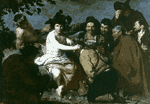Crucifixion

Las Meninas (The Maids in Waiting)

"After an extended visit to Rome
from 1648 to 1651, Velazquez returned to Spain and painted
his greatest masterpiece, Las Meninas (The Maids
of Honor). In it Velazquez showed his mastery of
both form and content. The painter represented himself
in the studio standing before a very large canvas, on which
he may be painting this very same picture or, perhaps, the
portraits of King Philip IV and Queen Mariana, whose
reflections appear in the mirror on the far wall. The
young Infanta (princess) Margarita appears in the
foreground with her two maids-in-waiting, her favorite
dwarfs, and a large dog. In the middle ground are a
woman in widow's attire and a male escort; in the background
a gentleman is framed in a brightly lit open doorway. ...
[A] duality of theme exists in the Velazquez painting.
It is both an informal family group portrait, seemingly
casually arranged and naturalistic, and it is a genre
painting - "A Visit to the Artist's Studio" would be an
equally apt title. The room represented in the
painting was in the palace of the Alcazar in Madrid.
After the death of Prince Baltasar Carlos in 1646, Philip IV
ordered part of the prince's chambers converted into a
studio for Velazquez."
- Gardner's
Art Through The Ages,
11th edition, Vol. II, pp. 744 - 746
**** insert
detail of Las Meninas here ****
"In the
Baroque period, when artists took Leonardo's dictum that
"the mirror is our master" very seriously, it is not
surprising to find mirrors and primitive camera-like devices
used to achieve optimum visual fidelity in paintings.
Las Meninas is a pictoral summary and a commentary on the
essential mystery of the visual world, as well as on the
ambiguity that results when different states or levels
interact or are juxtaposed."
- Gardner's
Art Through The Ages,
11th edition, Vol. II, p. 746
The Drunkards / The Triumph of Bacchus

"The contrast of lights and darks, along with the plebian
nature of the figures, reveal the influence of
Caravaggio, whose
work Velazquez had studied."
- Gardner's
Art Through The Ages,
11th edition, Vol. II, p. 743
|